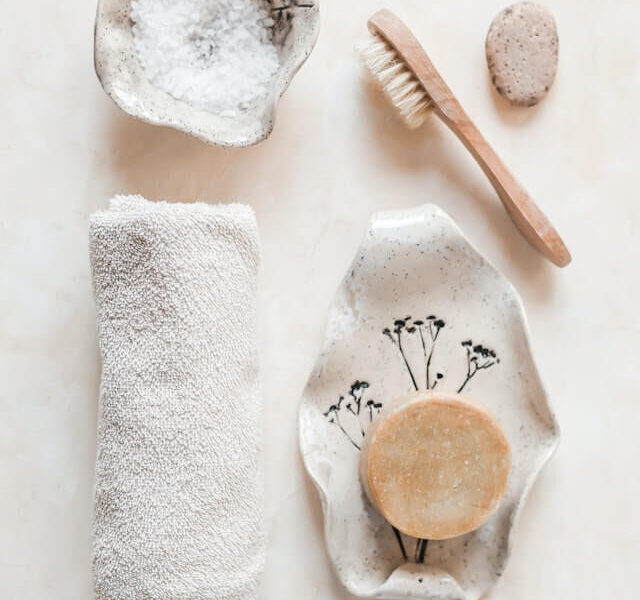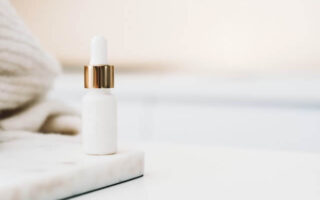We all know that exfoliation is an important step in any skincare regimen. But a wrong selection of exfoliants can lead to excessive dryness, irritation, inflammation, and even micro-tears in the skin.
So,
Which exfoliation, Physical vs Chemical Exfoliation, is right for your skin type?
What are the Chemical vs Physical Exfoliation benefits and drawbacks?
Can you use both Physical and Chemical Exfoliants?
Read on to find out!
But first, you need to understand the basics of exfoliation.
What does Exfoliate mean?
The term exfoliate refers to the process of removing dead skin cells from the surface of the skin. It can be done mechanically, using a scrub or brush, or chemically, using an exfoliating product that contains ingredients like alpha or beta hydroxy acids.
In the later sections, you will learn everything there is to know about Physical Exfoliation and Chemical Exfoliation in detail.
What does Exfoliating do?
Exfoliation is important for maintaining healthy skin, as it helps to remove debris and build-up of dead skin cells that can clog pores and lead to acne breakouts. In addition, it helps improve the skin’s appearance by revealing brighter, more evenly-toned skin beneath the surface. Regular exfoliation also helps reduce the appearance of fine lines and wrinkles, making the skin look younger and more radiant.
What is Chemical Exfoliation?
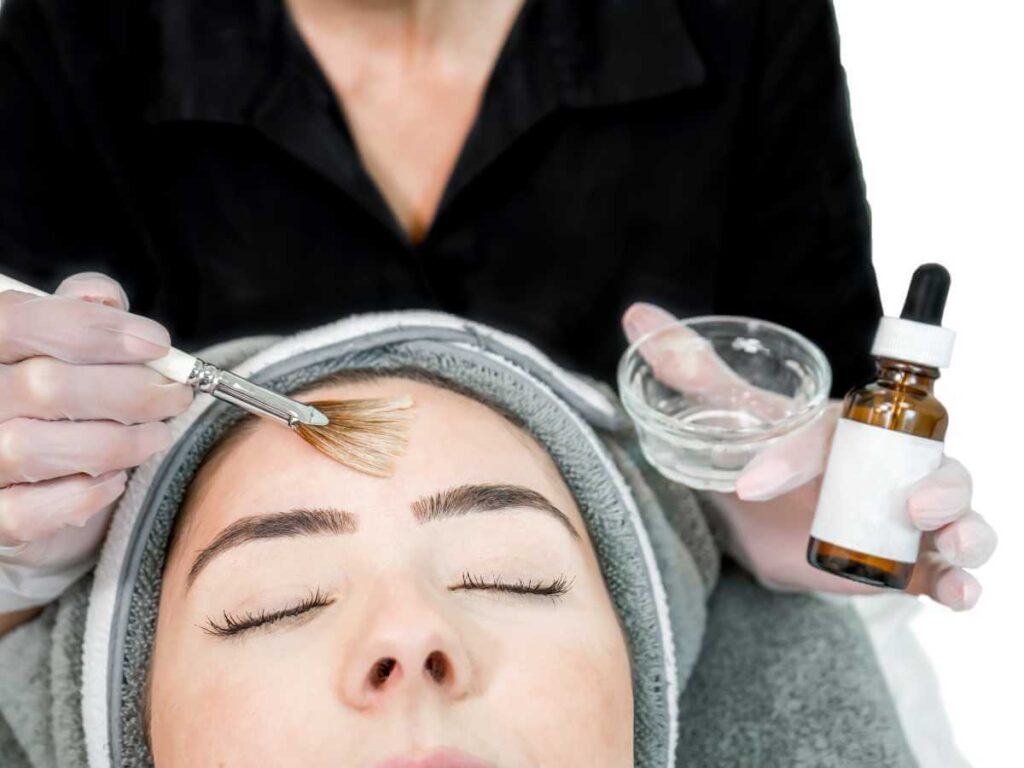
Chemical exfoliation is the process of removing dead skin cells from the skin’s surface using an exfoliating product containing ingredients like alpha or beta hydroxy acids. The ingredients and acids work to break down the bonds that hold dead skin cells together, allowing them to be sloughed away easily. Chemical exfoliation is often gentler on the skin, making it a good choice for those with sensitive skin.
What are Chemical Exfoliants?
Chemical exfoliants are acids that dissolve the bonds holding dead skin cells together, allowing them to be shed readily and revealing newer, healthier-looking skin beneath. Chemical exfoliants help to improve skin texture and reduce the appearance of blemishes by removing these dead skin cells.
Various chemical exfoliants are available on the market, each with unique benefits. Some popular options include Alpha Hydroxy Acids (AHA) and Beta Hydroxy Acids (BHA).
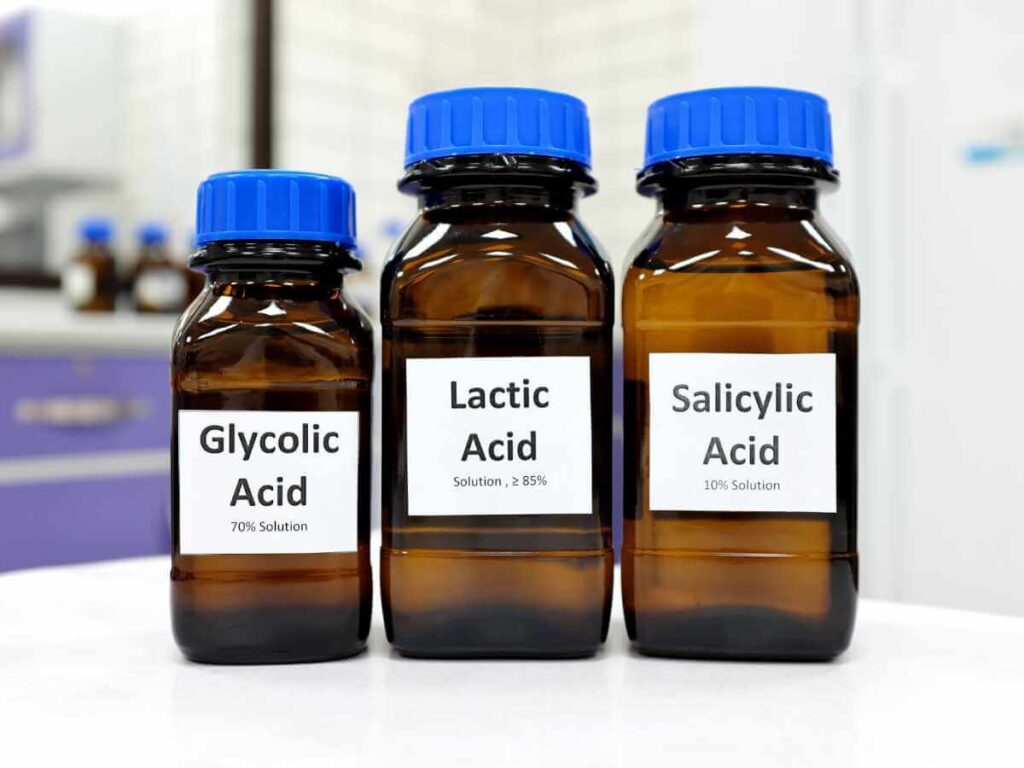
Alpha Hydroxy Acids (AHA)
Alpha Hydroxy Acids are one of the common acids found in chemical exfoliants. AHAs contain water-soluble acids, including glycolic acid, lactic acid, citric acid, malic acid, hydroxycaproic acid, hydroxycaprylic acid, and tartaric acid.
AHA helps improve your skincare routine in many ways, from moisturizing to preventing acne and wrinkles.
Beta Hydroxy Acids (BHA)
Beta Hydroxy Acids, such as salicylic acid, are oil-soluble acids that penetrate the pores to dissolve sebum and dead skin cells. It makes them ideal for treating acne, blackheads, and whiteheads. BHA also helps improve skin texture and reduce the appearance of blemishes.
Can I Use AHA And BHA Acids On My Skin?
Using both AHA and BHA acids on your skin can cause irritation, redness, and dryness. It is best to alternate between the two or use one in the morning and the other at night. If your skin is sensitive, start with a lower acid concentration and increase as tolerated.
How to use Chemical Exfoliant?
If you are considering using a chemical exfoliant, choosing one that is appropriate for your skin type is important. AHAs are generally appropriate for normal or dry skin, while BHAs are appropriate for oily or acne-prone skin.
Before using a chemical exfoliant, it is important to read the instructions carefully. Also, test it on a small skin patch first to ensure that you do not have an allergic reaction to the exfoliant.
Next, apply the exfoliant to a small skin patch and wait 24 hours to see if there is any redness or irritation to ensure you don’t have a delayed response. If there is no redness or irritation, you can proceed with using the exfoliant.
Step by Step Instruction:
- After you cleanse your face and neck, apply your chemical exfoliant. For example, if you’re using a liquid exfoliant, use a cotton pad, and if you’re using lotion or gel, use your fingers.
- When using a chemical exfoliant, apply it in an even layer and avoid getting it in your eyes. It’s safe to use around the eyes, though not on the eyelid or directly beneath.
- It’s fine to use any other product in your skincare routines – such as a lotion, serum, eye cream, or sunscreen – right after exfoliating.
Who Is Chemical Exfoliation For?
Chemical exfoliation is for anyone who wants to improve their skin appearance and complexion. It can address several concerns, including acne scars, dark spots, pigmentation, blackheads, wrinkles, fine lines, dullness, and dryness.
What type of skin is best suited for Chemical Exfoliation?
Whether you have dry skin, oily skin, or combination skin, you can benefit from using chemical exfoliants. There are different chemical acid exfoliants, so choosing the right one for your skin type is important.
BHA exfoliants are perfect for oily and acne-prone skin as they can help unclog pores and eliminate black and whiteheads.
Similarly, AHA exfoliants are beneficial for normal to dry skin as they can help increase hydration levels. But if you have sensitive skin, look for an exfoliant with a lower concentration of acids.
When to use Chemical Exfoliant?
Chemical exfoliants can be used 2-3 times a week, depending on your type of exfoliant and skincare regimen. If you have sensitive skin, start with once a week and increase the frequency gradually if your skin tolerates it well.
You can use chemical exfoliant in either your morning or night skincare regimen. If you’re using it in the morning, follow up with sunscreen, as chemical exfoliants can make your skin more sensitive to sunlight.
How do Chemical Exfoliants work?
Chemical exfoliants work by loosening the bonds that hold the dead skin cells to the surface of your skin. It lets them gently wash away the dead cells, revealing the brighter, smoother skin underneath.
Using the right exfoliants regularly can provide you with visible changes within a few weeks. You’ll notice that your skin looks healthier, feels softer, and has a more even complexion.
Are Chemical Exfoliants safe?
Chemical exfoliants are considered safe when used as directed, but there is always a risk of skin irritation and sunburn. If you experience any skin irritation or other adverse effects, discontinue use and consult a dermatologist.
Ingredients To Avoid In Chemical Exfoliators
Some common ingredients to avoid in chemical exfoliators are sulfates, which can be harsh and dry on the skin. They can also strip away the skin’s natural oils, leading to more dryness and irritation.
Is chemical exfoliation better than physical?
It depends on the individual’s skin type and preferences. Some people prefer the gentleness of chemical exfoliants, while others find that physical exfoliants are more effective at removing dead skin cells. However, chemical exfoliation is often considered more effective than physical exfoliation, as it can penetrate deep into the pores to remove dirt, oil, and dead skin cells. Ultimately, it is up to the individual to decide which type of exfoliant works best for them.
Benefits of Chemical Exfoliation
Benefits of chemical exfoliation include:
- Gentle and non-abrasive
- Ideal for people with sensitive skin
- Help reduce the appearance of fine lines and wrinkles
- Can be used more frequently than physical exfoliation
- Effective at unclogging pores and getting rid of blackheads and whiteheads
- Reduces the appearance of acne scars and dark spots
- Improves uneven skin texture
- Makes pores appear smaller
- Gives skin a radiant and healthy glow
- Hydrates dry skin
- Improves overall skin complexion
Side Effects of Chemical Exfoliation
Chemical exfoliation is generally safe for all skin types when used as directed. However, some people may experience temporary redness, stinging, or irritation.
However, starting slowly and increasing the frequency gradually is important to give your skin time to adjust.
Another potential side effect is sun sensitivity. Because chemical exfoliators can increase skin cell turnover, they may also make the skin more susceptible to sun damage. Therefore, it’s important to use sunscreen every day when using these products and avoid prolonged sun exposure.
If you have sensitive skin, choose an exfoliant with a lower concentration of acids. Stop using the product and consult a dermatologist in case of severe irritation and inflammation.
What Is Physical Exfoliation?

Physical exfoliation is the process of manually sloughing off dead skin cells from the surface of your skin using physical substances. It can be done in many ways, the most common being scrubs. Scrubs typically contain small, abrasive particles like sugar or salt that help to loosen and remove dead skin cells.
What are Physical Exfoliants?
Physical exfoliants are ingredients that help remove dead skin cells from the surface of your skin. They can come in the form of a scrub, a peel, or a mask. Some common ingredients in physical exfoliants include sugar, salt, and baking soda.
Physical exfoliation can be done with either a manual or mechanical exfoliant. Manual exfoliants are products, such as scrubs, that you use to scrub the skin physically. Mechanical exfoliants are devices, such as brushes or cloths, that have a rough surface and are used to scrub the skin mechanically.
Who Is Physical Exfoliation For?
Physical exfoliation is beneficial for individuals with thick skin. But it is also for people looking to get a deep cleanse and remove all the built-up dirt, oil, and dead skin cells to reveal brighter, smoother, and younger-looking skin.
What Type Of Skin Is Best Suited For Physical Exfoliation?
Physical exfoliation is great for oily and thick skin types, as it can help remove the built-up oils and dead skin cells that can cause dry patches.
Physical exfoliation is the easiest way to exfoliate your arms, legs, and backs.
Ingredients To Avoid In Physical Exfoliators
You should avoid any ingredients in physical exfoliators that can be harsh on the skin. For example, sugar, salt, and ground oats can cause irritation and redness. It’s best to stick with gentle exfoliators that use natural ingredients like fruit enzymes or jojoba beads.
Are Physical Exfoliants bad?
There is no right or wrong answer to this question, as everyone’s skin will react differently to physical exfoliants. Physical exfoliation can improve the condition of your skin, especially on your arms, legs, and back. However, it is important to be aware of the potential risks associated with using physical exfoliants. For example, if you use a physical exfoliant that includes big, rough particles with sharp edges, you can get micro-tears in the skin, which might cause irritation, inflammation, and perhaps infection.
Benefits of Physical Exfoliation
Benefits of physical exfoliation include:
- Help slough off dead skin cells, which can improve the appearance of your skin
- Help to unclog pores and prevent breakouts
- Help reduce the appearance of fine lines and wrinkles
- Help improve the absorption of skincare products
Drawbacks of physical exfoliation
Drawbacks of physical exfoliation include:
- Can irritate the skin if done too often or too aggressively
- Can cause microtears in the skin
- Can be drying on the skin
- Can be too harsh for some skin types, causing irritation, redness, and inflammation
- If you have active acne, it can spread bacteria and cause further breakouts
- Can damage the protective barrier of the skin
Physical Exfoliation vs Chemical Exfoliation: Which is safer for sensitive skin?
People with sensitive skin should avoid physical and mechanical exfoliants. Harsh physical exfoliants can cause more irritation and tiny tears in already delicate skin.
There are a few things that people with sensitive skin should keep in mind when exfoliating.
First, it is important to choose an exfoliant that is gentle and designed for sensitive skin. Chemical exfoliants are beneficial in these cases. Whether you want to use chemical serums, peels, or pads, you have many alternatives.
Secondly, it’s important to use the product as directed and not overdo it. Some may believe that more frequent use can lead to quicker benefits, but that’s not always the case. In fact, overusing skincare products can lead to adverse effects, such as drying out your skin or making it more susceptible to irritation. Read the instructions before using any new product, and start by using it sparingly to see how your skin reacts.
Finally, it is important to moisturize after exfoliating to help soothe the skin.
Follow these basic steps to rejuvenate and replenish your sensitive skin.
Can I do both Chemical and Physical Exfoliation?
It is possible to do both chemical and physical exfoliation, but it is important to be aware of the differences between the two types of exfoliants. Chemical exfoliants are generally more effective at removing dead skin cells from your face. In contrast, physical exfoliants are better at removing excess build-up of dead skin cells and oils from your body’s skin, especially your arms, legs, and backs.
The two types of exfoliators, chemical exfoliator vs physical exfoliator, can have different effects on the skin, and combining them could lead to irritation or other side effects for some people. So, make sure not to over-exfoliate your skin, and start with one type of exfoliant before slowly incorporating the other.
Learn More “Can I use both physical and chemical exfoliant?“
How to Exfoliate Based on Your Skin Type?
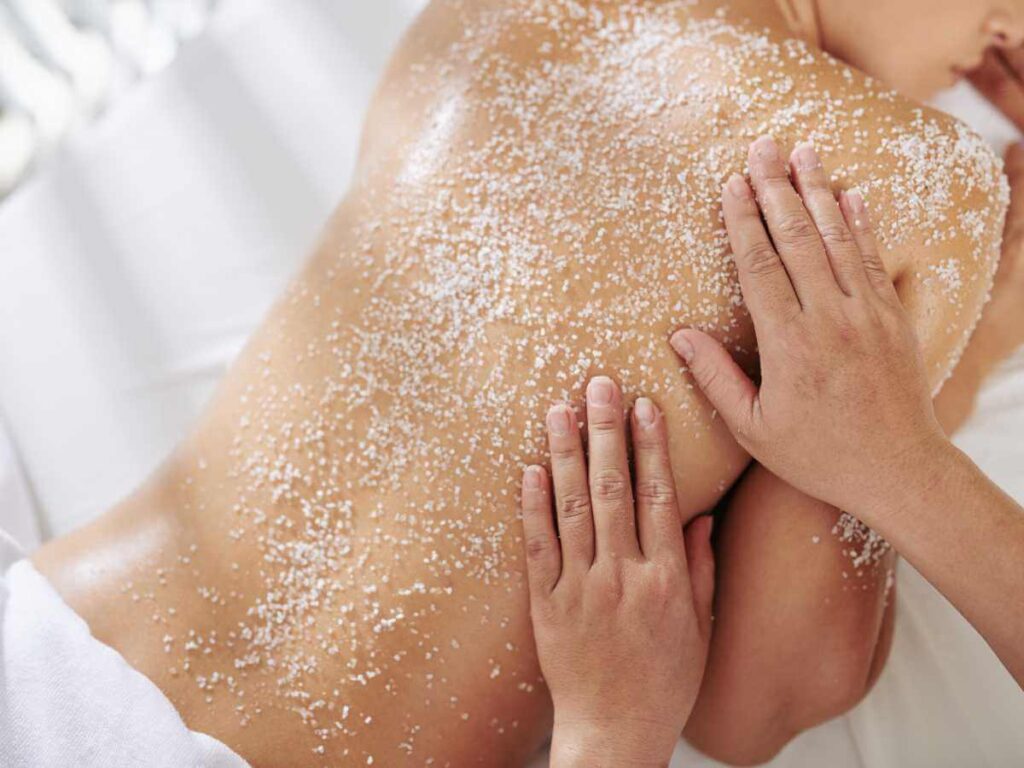
The best way to exfoliate your skin depends on your skin type.
How to exfoliate normal or combination skin?
To exfoliate normal or combination skin, use a gentle chemical exfoliant such as an Alpha Hydroxy Acid (AHA) or Beta Hydroxy Acid (BHA). These acids dissolve the bonds that hold dead skin cells together, allowing them to be easily washed away. Avoid using harsh physical exfoliants like scrubbing beads which can damage your skin.
How to exfoliate sensitive skin?
People with sensitive skin should be careful about using physical or mechanical exfoliants. Harsh mechanical exfoliation can cause more irritation and tiny tears in sensitive skin.
To exfoliate sensitive skin, use a gentle chemical exfoliant with Alpha Hydroxy Acid (AHA) or Beta Hydroxy Acid (BHA).
How to exfoliate oily skin?
To exfoliate oily skin, use a gentle physical or manual exfoliant. These exfoliants help to remove excess oil and debris from the pores, leaving the skin looking and feeling refreshed.
You can always use chemical exfoliants with Beta Hydroxy Acid (BHA) if you don’t prefer manual exfoliation.
How to exfoliate dry skin?
People with dry skin should avoid using mechanical exfoliants as they can further dry and cause micro-tears. AHA is beneficial for dry skin. Not only can glycolic acid exfoliate your skin, but it also encourages healthy cell turnover.
However, after using this product, be sure to follow up with an SPF and moisturizer to protect your skin from any potential sun damage that could occur as a result of the AHA.
How to exfoliate melanin-rich or dark skin?
Melanin-rich or dark skin often comes with uneven skin tone, hyperpigmentation, and texture abnormalities. So it’s important to be especially careful when exfoliating such skin type. Use a gentle chemical exfoliant that won’t cause any irritation. AHAs are a good choice for dark skin, as they can help to remove dead skin cells and brighten the complexion. Be sure to use sunscreen after exfoliating to protect your skin from further damage.
How Often To Exfoliate?
To keep your skin looking its best, it’s important to exfoliate regularly. How often you should exfoliate depends on your skin type and the type of exfoliant you use.
Depending on your skin type, exfoliating could be necessary anywhere from once a week to once a month. If unsure how often you should be exfoliating, ask your dermatologist for their professional opinion.
You can start by exfoliating once a week and see how your skin reacts. If your skin feels dry or sensitive, you may need to exfoliate less often. But if your skin looks dull and acne prone, you may need to increase your exfoliation frequency.
When starting out, it’s always better to err on the side of caution. You can always increase the frequency if you find your skin can handle it. Exfoliating too often can lead to irritation, redness, and dryness.
Similarly, the frequency with which you need to exfoliate your skin depends on the type of exfoliant you use. Physical exfoliants are more likely to irritate, so you’ll need to use them less often. Chemical exfoliants are gentler and can be used once or twice a week.
How To Exfoliate The Skin?
There are several ways to exfoliate the skin, including using a scrub, chemical exfoliant and more.
To exfoliate the skin using a scrub, wet your skin and apply a dollop of scrub to your fingertips. Gently massage the scrub into your skin in circular motions for two to three minutes, then rinse it with warm water.
If you’re looking for a less intensive exfoliation method, consider utilizing a gentle chemical exfoliant. To sweep your face gently with the exfoliant, apply it to a cotton ball or pad and then massage your skin over it. After that, apply your skincare products on top of it.
Tips for Proper Exfoliation
Exfoliation is an important part of any skincare routine, but it can be tricky to know how to do it properly. Here are a few tips to help you get the most out of your exfoliation routine:
- Always use a gentle exfoliator. If your skin is sensitive, use a product that is specifically designed for sensitive skin.
- Don’t overdo it. Exfoliating too often can irritate your skin and make it dry and flaky. Instead, try to limit yourself to once or twice a week.
- Use circular motions. It will help to dislodge any dirt or dead skin cells from your pores.
- Rinse well. Make sure to rinse off all of the exfoliators, or you might end up with irritated skin.
- Moisturize your skin. Exfoliation can leave your skin feeling a bit dry, so make sure to moisturize afterward.
If you follow these tips, you should be able to get the most out of your exfoliation routine and have healthy, happy skin.
Final Verdict:
Chemical Exfoliation vs Physical Exfoliation: Should you use physical or chemical exfoliants?
There are pros and cons to using both physical and chemical exfoliants. A physical exfoliant, such as a scrub, is best for thick skin such as backs, arms, and legs. It can also help dislodge blackheads and whiteheads. However, it can be harsh on sensitive skin.
In my professional opinion, chemical exfoliation is better for exfoliating your face and neck areas. They’re less likely to cause irritation and inflammation compared to physical exfoliants.
But ultimately, it comes down to your personal preference regarding which type of exfoliant you want to use – just make sure you read the instructions carefully. Hence, you know how to use them safely and effectively.
Overall, a physical and chemical exfoliant can be a great way to achieve healthy, glowing skin. However, it’s important to ensure you use the right products for your skin type.

